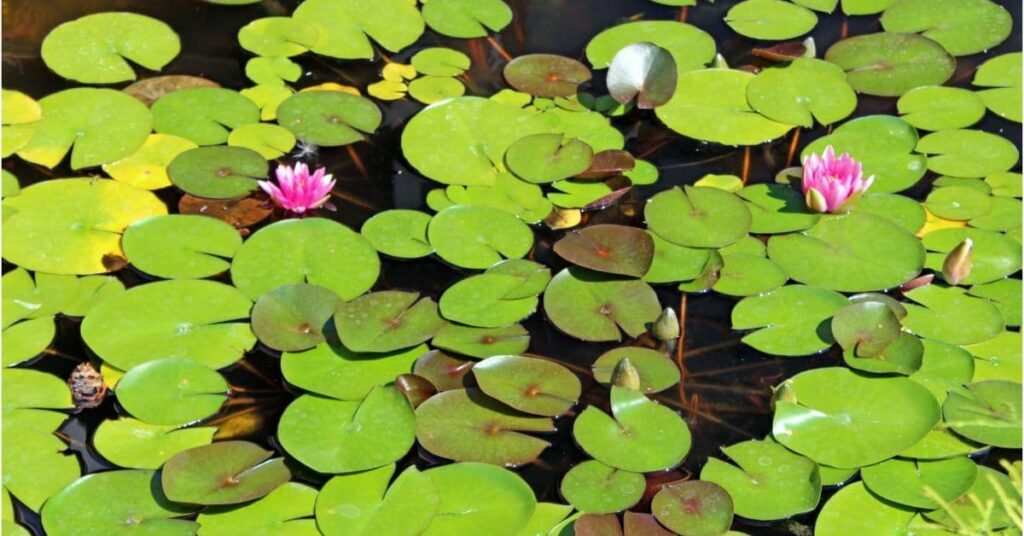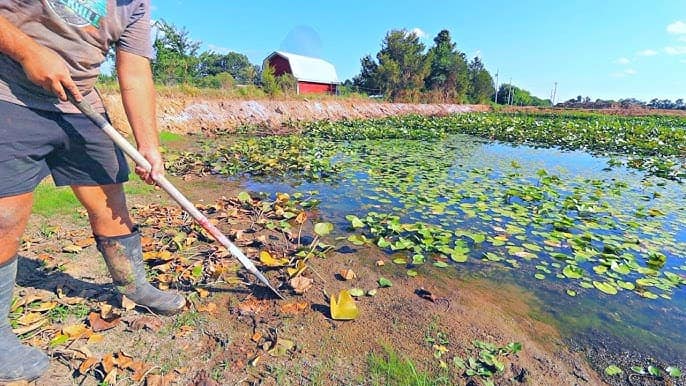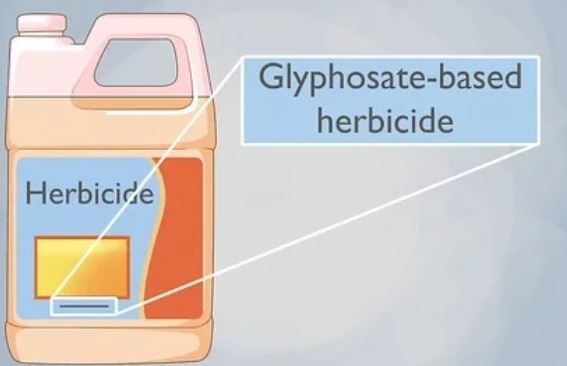How to Do You Kill Lily Pads Without Harming Fish? Pond Weed Removal
For pond owners and managers, overgrow lily pads are often a major problem.
If you are going to remove some of these lily pads, it is crucial that you don’t kill or harm any of the fish in your pond.
So how do you kill lily pads without harming fish?
There are actually a few ways that you can successfully get rid of this vegetation without any harm to the pond wildlife.
Why Would You Need to Get Rid of Lily Pads?
Overgrown and overpopulated lily pads are both ugly and potentially harmful to the fish and other wildlife in the pond.
The reflective and flowing aesthetic of the water itself is what makes ponds to pretty and attractive.
If the whole surface is covered in lily pads, it gives a sloppy and overgrown look that ruin the view.
The over populated vegetation can also suck out too much oxygen from the water as well as reduce the usable water that is available to the fish.
This can lead to fish growing very slowly or even dying.
How Many Lily Pads Should You Have?
This is mostly up to you as the pond owner or manager. But ideally speaking, the pond should be 15-25 percent covered with vegetation.
This number is the sum of all the weeds and vegetation in your pond.
So if you have submerged weeds as well, you will need to remove extra lily pads.
How to Kill Lily Pads Without Harming Fish?
Like I said earlier, there are multiple ways to kill the lily pads in a pond or lake without killing or harming the fish and wildlife.
1. Physical and Mechanical Lily Pad Removal
This method will require the most work and manual labor, but it is very effective and keeps the lily pads at bay long term.
Using either your bare hands, a pond rake, or machines and boat attachments, you are going to actually rip the lily pads right out of the bottom.
Because of the constant saturation of the pond floor, the plants actually come up very easily and you can kill a lot of lily pads in a fairly quick time period.
This method doesn’t cause any harm to the fish and aquatic creatures.
The creatures will get scared and moved away temporarily, but other than that, pulling up the lily pads yourself is completely harmless and risk free.
The obvious downside to this method is that it requires a lot of work and for you to get a bit wet.
2. Specialized, Fish Safe Herbicides
There are specialized pond herbicides that kill lily pads without causing any harm or danger to the fish.
A couple of these are Airmax Wipeout and Aquacide Pellets. These chemical treatments work very well and will kill the unwanted lily pads.
However, even though they are designed and tested to be safe for the fish, you are still adding unnatural chemicals to your pond.
Some people have a hard time doing this even though it is a safe option.
These herbicides are a much easier and more convenient option, but many pond owners still have reservations about them.
3. Pressure Washer
This is more of a temporary option that is ideal for small areas of your pond.
If your dock, boat ramp, or other important area of the pond is infested with lily pads, you can use a pressure washer to clear out the area temporarily.
The powerful jet stream of water tears up the plants and pushes them away from area.
The pressure washer does have its limitations. It is only going to work with about a 5-10 foot range and many of the lily pads will grow back after a couple months.
But this is a great method if you only need to clear out small areas of your pond.
4. Carp and Plankton (Overgrowth Prevention)
These are tactics for when you recently acquired a pond or you have already removed the lily pads and you want to prevent future overgrowth.
Adding carp and plankton to the pond will keep the lily pads and other weeds from growing out of control.
The carp will eat lots of the lily pad seeds and roots, keeping them from growing too much and getting out of control.
The plankton will use up some of the nutrients in the pond that the lily pads would have been using.
But more importantly, the plankton floats around in the water and reduces water clarity and visibility.
This reduces the amount of sunlight that reaches down into the water.
This is more effective against subsurface weeds because lily pads absorb most of the sunlight from the big leaves above the water.
Adding carp and plankton to the pond is a great long term tactic to prevent lily pads from growing too much.
FAQ
Will Round Up Kill Lily Pads?
No, Round Up is not going to effectively kill lily pads and can be very harmful to the fish and other wildlife.
The Round Up becomes too diluted in the water to have any real effect.
Will Vinegar Kill Lily Pads?
No, vinegar will dilute immediately in the water and will not work to kill or remove lily pads.
Are Lily Pads Bad for Fish?
No, as long as they are not overgrowing, lily pads are actually very good for fish and create a great environment and habitat in the pond or lake.
Lily pads are only bad for fish when they become very overgrown and invasive.
Clearing this Out
There are multiple strategies to kill lily pads without harming fish. Each one of them will require some work and time to see results, but it is well worth it.
Whether you are a pond owner, manager, or have been hired to remove lily pads, the four methods above are the best and safest ways to get the job done.
Target 15-25 percent of total vegetation coverage in your pond, and the fish and other aquatic wildlife will thrive.
Proper vegetation and structure, whether it is natural or artificial pond structure, are very important when creating a healthy fish habitat.











